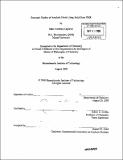| dc.contributor.advisor | Robert G. Griffin. | en_US |
| dc.contributor.author | Caporini, Marc Anthony | en_US |
| dc.contributor.other | Massachusetts Institute of Technology. Dept. of Chemistry. | en_US |
| dc.date.accessioned | 2009-06-30T17:06:55Z | |
| dc.date.available | 2009-06-30T17:06:55Z | |
| dc.date.copyright | 2008 | en_US |
| dc.date.issued | 2008 | en_US |
| dc.identifier.uri | http://hdl.handle.net/1721.1/46038 | |
| dc.description | Thesis (Ph. D.)--Massachusetts Institute of Technology, Dept. of Chemistry, 2008. | en_US |
| dc.description | Vita. | en_US |
| dc.description | Includes bibliographical references. | en_US |
| dc.description.abstract | he development of solid-state NMR techniques and application to amyloid fibrils are presented. In addition, a new method of selective inversion based on chemical shift anisotropy is presented. An improved method for highly accurate distance measurement across parallel [beta]-sheets in amyloid fibrils has been developed. This method combines the a double quantum filtered version of the dipolar recoupling sequence DRAWS with the simulation and data fitting program SPINEVOLUTION to provide a simple and effective way to measure interstrand distances. This method was applied to TTR105.115 fibrils. Several other methods were applied to the TTR fibrils to measure interstrand and intersheet distances including REDOR, TEDOR, R2TRW, and DARR. The intermolecular distances were combined with the previously solved monomer structure to generate a high resolution (RMSD of 1.0 Å) of the TTR protofiliment. A disease associated mutant (L 11 M) of these fibrils was also studied by solid-state NMR to determine the monomer structure. Distance measurements on this system were done via 3D TEDOR and R2W, and torsion angle were also measured. A high resolution structure of the monomer is presented. Some non-fibril related research concerning the exploration of chemical shift anisotropy and cross polarization is presented in the later chapters. Both experimental evidence and a theoretical framework are presented to demonstrate the phenomenon of selective inversion based on the size of the chemical shift anisotropy. Further work concerning the use of cross polarization selectively was developed and is presented. | en_US |
| dc.description.statementofresponsibility | by Marc Anthony Caporini. | en_US |
| dc.format.extent | 92 p. | en_US |
| dc.language.iso | eng | en_US |
| dc.publisher | Massachusetts Institute of Technology | en_US |
| dc.rights | M.I.T. theses are protected by
copyright. They may be viewed from this source for any purpose, but
reproduction or distribution in any format is prohibited without written
permission. See provided URL for inquiries about permission. | en_US |
| dc.rights.uri | http://dspace.mit.edu/handle/1721.1/7582 | en_US |
| dc.subject | Chemistry. | en_US |
| dc.title | Structural studies of amyloid fibrils using solid-state NMR | en_US |
| dc.type | Thesis | en_US |
| dc.description.degree | Ph.D. | en_US |
| dc.contributor.department | Massachusetts Institute of Technology. Department of Chemistry | |
| dc.identifier.oclc | 368148272 | en_US |
